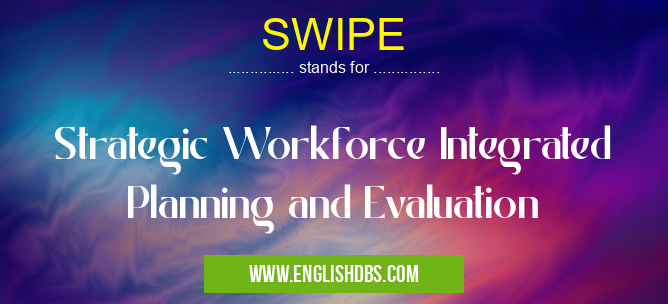What does SWIPE mean in PLANNING
SWIPE is a comprehensive framework that aligns workforce planning, talent management, and performance evaluation to support organizational strategic objectives. It provides a holistic approach to workforce management, ensuring the right talent is in the right place, at the right time, with the right skills.

SWIPE meaning in Planning in Governmental
SWIPE mostly used in an acronym Planning in Category Governmental that means Strategic Workforce Integrated Planning and Evaluation
Shorthand: SWIPE,
Full Form: Strategic Workforce Integrated Planning and Evaluation
For more information of "Strategic Workforce Integrated Planning and Evaluation", see the section below.
» Governmental » Planning
Key Features of SWIPE
- Integrated Approach: SWIPE combines workforce planning, evaluation, and talent development into a cohesive framework, ensuring a holistic approach to human capital management.
- Data-Driven Planning: SWIPE relies on data and analytics to inform workforce planning decisions, ensuring that strategies are based on objective insights.
- Focus on Talent: SWIPE emphasizes talent acquisition, development, and retention as critical components for organizational success.
- Continuous Improvement: SWIPE incorporates ongoing evaluation and feedback mechanisms to monitor progress and make necessary adjustments to ensure continuous improvement.
Benefits of SWIPE
- Improved Workforce Planning: SWIPE enables organizations to forecast future workforce needs and develop strategies to address potential gaps.
- Enhanced Performance Evaluation: SWIPE provides a systematic approach to evaluating employee performance and identifying areas for improvement.
- Targeted Talent Development: SWIPE helps organizations identify and develop future leaders and key talent, ensuring a robust pipeline of skilled professionals.
- Increased Organizational Effectiveness: By aligning workforce strategies with business goals, SWIPE contributes to improved organizational efficiency, productivity, and competitiveness.
Essential Questions and Answers on Strategic Workforce Integrated Planning and Evaluation in "GOVERNMENTAL»PLANNING"
What is Strategic Workforce Integrated Planning and Evaluation (SWIPE)?
How does SWIPE work?
SWIPE integrates workforce planning, talent management, and performance evaluation through a cyclical process involving data collection, analysis, planning, implementation, and evaluation. It aligns workforce needs with organizational goals, identifies talent gaps, develops and deploys talent, and measures the impact of workforce initiatives.
What are the benefits of using SWIPE?
SWIPE offers numerous benefits, including improved workforce planning, enhanced talent management, optimized performance evaluation, increased organizational agility, and reduced costs. It helps organizations attract and retain top talent, develop future leaders, and align workforce strategies with business outcomes.
How is SWIPE different from traditional workforce management approaches?
Unlike traditional approaches that focus on individual components of workforce management, SWIPE takes a holistic view, integrating all aspects into a cohesive framework. It emphasizes data-driven decision-making, continuous improvement, and a focus on strategic alignment.
What are the key elements of SWIPE?
SWIPE encompasses five key elements: Workforce Planning, Talent Management, Performance Evaluation, Metrics and Measurement, and Continuous Improvement. These elements work together to provide a comprehensive view of the workforce and its alignment with organizational goals.
How can organizations implement SWIPE effectively?
Implementing SWIPE requires a collaborative effort involving HR, business leaders, and employees. It should be supported by a strong data infrastructure, clear communication, and a commitment to continuous improvement. Organizations should tailor the framework to their specific needs and context.
What are some examples of SWIPE in practice?
SWIPE has been applied in various industries, including healthcare, finance, and technology. Examples include developing talent pipelines for critical roles, aligning performance goals with organizational objectives, and using data to identify and address workforce gaps.
Final Words: SWIPE is an essential tool for modern organizations seeking to optimize their human capital management practices. By integrating workforce planning, evaluation, and talent development, SWIPE enables organizations to build a workforce that is equipped to meet the challenges and opportunities of the future.
